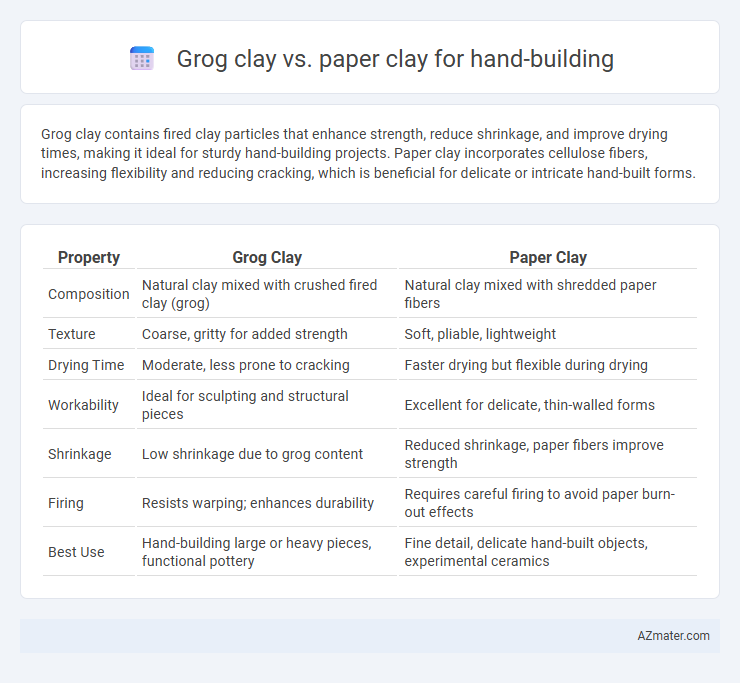Grog clay enhances ceramic durability and thermal shock resistance due to its pre-fired, coarse particle composition, while ball clay provides superior plasticity and smooth texture for intricate shaping and fine details. Combining grog clay and ball clay optimizes ceramic strength and workability, essential for functional and artistic pottery.
Table of Comparison
| Property | Grog Clay | Ball Clay |
|---|---|---|
| Texture | Coarse, granular | Fine, smooth |
| Plasticity | Low to medium | High |
| Firing Temperature | High (1200-1300degC) | Moderate (1100-1200degC) |
| Porosity | High | Low |
| Role in Ceramics | Improves strength, reduces shrinkage | Enhances workability, plasticity |
| Composition | Fired and crushed clay particles | Kaolinite, mica, quartz mix |
Introduction to Grog Clay and Ball Clay
Grog clay contains pre-fired clay particles that enhance strength and reduce shrinkage, making it ideal for sculptural ceramics and pottery requiring durability. Ball clay is a highly plastic, fine-grained clay with excellent workability and plasticity, commonly used in ceramic bodies to improve shaping and surface finish. Both clays serve distinct purposes: grog clay for structural support and firing stability, ball clay for flexibility and smooth texture in ceramic production.
What is Grog Clay?
Grog clay consists of crushed, pre-fired clay particles added to raw clay to improve its strength, reduce shrinkage, and enhance thermal shock resistance in ceramics. Grog, typically made from fired kaolin or fireclay, provides structural support and minimizes warping during drying and firing processes. Unlike ball clay, which is fine and plastic, grog clay is coarse and primarily acts as a tempering agent to create more durable ceramic bodies.
What is Ball Clay?
Ball clay is a highly plastic and fine-textured sedimentary clay primarily composed of kaolinite, used extensively in ceramics for its exceptional plasticity and smooth consistency. It enhances the workability of clay bodies, improves green strength, and contributes to a smoother surface finish, making it an essential ingredient in porcelain, sanitaryware, and tile production. Compared to grog clay, which provides strength and thermal shock resistance through coarse, fired clay particles, ball clay focuses on plasticity and molding ease in ceramic formulations.
Key Differences Between Grog Clay and Ball Clay
Grog clay contains pre-fired particles that enhance thermal shock resistance and reduce shrinkage, making it ideal for sculpting and functional ceramics, while ball clay offers superior plasticity and smooth texture, promoting easier shaping and finer detail in pottery. Grog's coarse texture improves strength and porosity, whereas ball clay's fine particles contribute to better workability but can increase shrinkage and warping during firing. The choice depends on the desired balance between durability and malleability in ceramic production.
Workability and Plasticity Comparison
Grog clay enhances workability by improving drying shrinkage and reducing cracking, making it ideal for hand-building and wheel throwing. Ball clay offers superior plasticity due to its fine particle size and high kaolinite content, allowing for easy shaping and detailed molding. Combining grog with ball clay balances plasticity and strength, optimizing ceramic piece durability and ease of manipulation.
Firing Properties and Temperature Ranges
Grog clay offers enhanced thermal stability and reduced shrinkage during firing, making it ideal for high-temperature ceramics typically fired between 1200degC and 1400degC. Ball clay, characterized by its fine particle size and high plasticity, fires at lower temperatures around 1000degC to 1150degC but can lead to increased shrinkage and warping if not carefully managed. The choice between grog clay and ball clay directly impacts the durability and warping resistance of ceramic products depending on the firing temperature and desired structural properties.
Impact on Final Ceramic Strength
Grog clay enhances the structural strength of ceramics by improving thermal shock resistance and reducing shrinkage during firing, which minimizes cracking and warping. Ball clay, known for its fine particle size and plasticity, increases workability but can reduce fired strength if used excessively due to higher shrinkage and potential for cracking. Optimal ceramic formulations balance grog clay's reinforcement properties with ball clay's plasticity to maximize final strength and durability.
Suitability for Handbuilding vs. Wheel Throwing
Grog clay enhances structural integrity and reduces shrinkage, making it ideal for handbuilding techniques that require strength and texture. Ball clay offers fine plasticity and smooth surface finish, which suits wheel throwing by allowing precise shaping and detailed work. The coarse particles in grog improve drying and firing stability, while ball clay's softness benefits delicate wheel-thrown ceramics.
Common Uses in Ceramics
Grog clay, composed of crushed fired clay particles, is commonly used in ceramics to enhance thermal shock resistance and reduce shrinkage during firing, making it ideal for sculptural work, pottery, and kiln furniture. Ball clay, characterized by its fine particle size and high plasticity, is frequently utilized in ceramic bodies to improve workability, green strength, and surface finish, particularly in fine china, porcelain, and sanitary ware. Both materials play crucial roles in ceramic formulation, with grog clay providing structural stability and ball clay contributing to plasticity and smooth texture.
Choosing the Right Clay for Your Ceramic Project
Grog clay enhances strength and reduces shrinkage, making it ideal for sculptural and high-fire ceramics, while ball clay offers excellent plasticity, which is perfect for intricate wheel-throwing and fine-detail work. Selecting grog clay benefits projects requiring durability and texture, whereas ball clay suits forms demanding smoothness and flexibility. Understanding the distinct properties of these clays ensures optimal performance and desired aesthetics in your ceramic creations.

Infographic: Grog clay vs Ball clay for Ceramics
 azmater.com
azmater.com